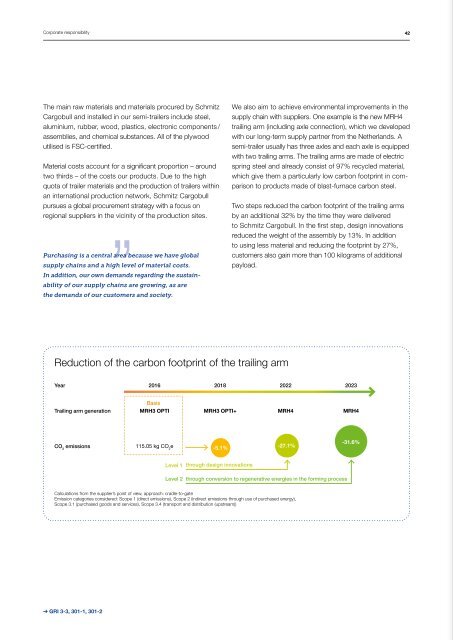You also want an ePaper? Increase the reach of your titles
YUMPU automatically turns print PDFs into web optimized ePapers that Google loves.
Corporate responsibility<br />
42<br />
The main raw materials and materials procured by Schmitz<br />
Cargobull and installed in our semi-trailers include steel,<br />
aluminium, rubber, wood, plastics, electronic components /<br />
assemblies, and chemical substances. All of the plywood<br />
utilised is FSC-certified.<br />
Material costs account for a significant proportion – around<br />
two thirds – of the costs our products. Due to the high<br />
quota of trailer materials and the production of trailers within<br />
an international production network, Schmitz Cargobull<br />
pursues a global procurement strategy with a focus on<br />
regional suppliers in the vicinity of the production sites.<br />
Purchasing is a central area because we have global<br />
supply chains and a high level of material costs.<br />
In addition, our own demands regarding the sustainability<br />
of our supply chains are growing, as are<br />
the demands of our customers and society.<br />
We also aim to achieve environmental improvements in the<br />
supply chain with suppliers. One example is the new MRH4<br />
trailing arm (including axle connection), which we developed<br />
with our long-term supply partner from the Netherlands. A<br />
semi-trailer usually has three axles and each axle is equipped<br />
with two trailing arms. The trailing arms are made of electric<br />
spring steel and already consist of 97% recycled material,<br />
which give them a particularly low carbon footprint in comparison<br />
to products made of blast-furnace carbon steel.<br />
Two steps reduced the carbon footprint of the trailing arms<br />
by an additional 32% by the time they were delivered<br />
to Schmitz Cargobull. In the first step, design innovations<br />
reduced the weight of the assembly by 13%. In addition<br />
to using less material and reducing the footprint by 27%,<br />
customers also gain more than 100 kilograms of additional<br />
payload.<br />
Reduction of the carbon footprint of the trailing arm<br />
Year 2016 2018 <strong>2022</strong> 20<strong>23</strong><br />
Basis<br />
Trailing arm generation MRH3 OPTI MRH3 OPTI+ MRH4 MRH4<br />
CO 2<br />
emissions<br />
115.05 kg CO 2<br />
e<br />
-5.1%<br />
-27.1%<br />
-31.6%<br />
Level 1 through design innovations<br />
Level 2 through conversion to regenerative energies in the forming process<br />
Calculations from the supplier’s point of view, approach: cradle-to-gate<br />
Emission categories considered: Scope 1 (direct emissions), Scope 2 (indirect emissions through use of purchased energy),<br />
Scope 3.1 (purchased goods and services), Scope 3.4 (transport and distribution (upstream))<br />
➔ GRI 3-3, 301-1, 301-2
















